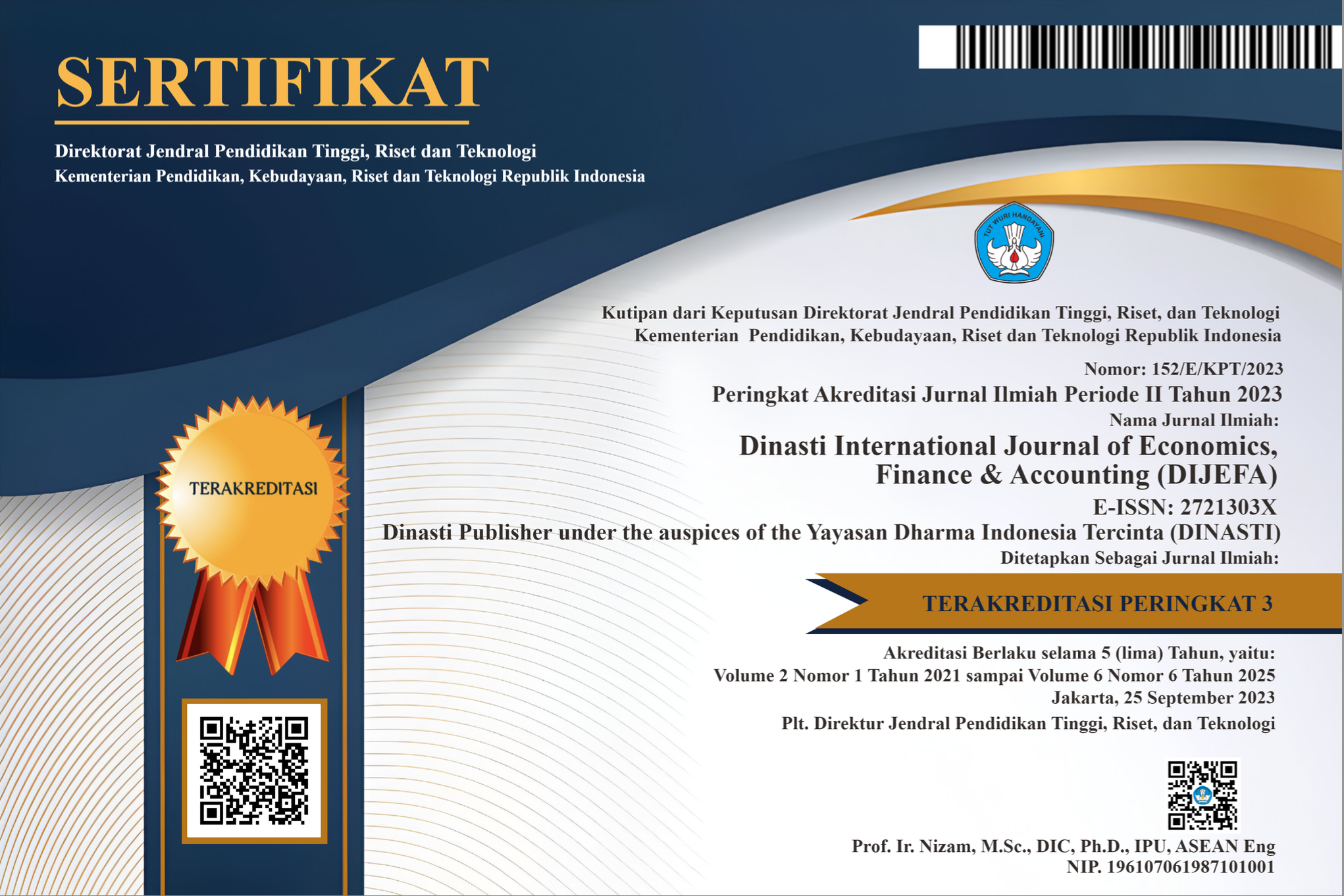MODEL OF STUDENT INVESTMENT INTENTION WITH FINANCIAL KNOWLEDGE AS A PREDICTOR THAT MODERATED BY FINANCIAL SELFEFFICACY AND PERCEIVED RISK
DOI:
https://doi.org/10.38035/dijefa.v1i1.232Keywords:
Investment Intentions, Financial Knowledge, Financial Self-efficacy, Perceived Risk.Abstract
This study aims to predict students' investment intentions in the Indonesia Stock Exchange. The questions in this study are whether financial knowledge shows a significant effect on student investment intentions on the Indonesia Stock Exchange, whether financial self-eficacy shows a significant effect in strengthening or weakening student investment intentions on the Indonesia Stock Exchange and whether the perceived risk shows a significant effect in strengthening or weakening student investment intentions in the Indonesia Stock Exchange. The analysis technique in this study using SPSS ver.21 and analyzed by regression PROCESS v3.4 by Andrew F. Hayes. The sampling method is purposive sampling, with several criteria developed previously. Questionnaires are used to collect data from respondents. Respondents in this study were students at the University of Pamulang, South Tangerang. A total of 400 respondents participated. Based on the analysis, Financial Knowledge influences students' investment intentions on the Indonesia Stock Exchange. Financial self-efficacy does not shows a significant influence in strengthening student investment intentions on the Indonesia Stock Exchange. The perceived risk shows a significant effect in weakening students' investment intentions on the Indonesia Stock Exchange.
References
finance, 10(5), 515-528.
Akhtar, F., & Das, N. (2019). Predictors of investment intention in Indian stock markets:
Extending the theory of planned behaviour. International Journal of Bank Marketing,
37(1), 97-119.
Alba, J. W., & Hutchinson, J. W. (2000). Knowledge calibration: What consumers know and
what they think they know. Journal of consumer research, 27(2), 123-156.
Almenberg, J., & Dreber, A. (2015). Gender, stock market participation and financial
literacy. Economics Letters, 137, 140-142.
Al?Tamimi, H. A. H. (2009). Financial literacy and investment decisions of UAE investors.
The Journal of Risk Finance.
Amatucci, F. M., & Crawley, D. C. (2011). Financial self?efficacy among women
entrepreneurs. International Journal of Gender and Entrepreneurship.
Badunenko, O., Barasinska, N., & Schäfer, D. (2009). Are private equity investors good or evil?.
Baker, H. K., & Nofsinger, J. R. (Eds.). (2010). Behavioral finance: investors, corporations,
and markets (Vol. 6). John Wiley & Sons.
Bandura, A. (1977). Self-efficacy: toward a unifying theory of behavioral change.
Psychological review, 84(2), 191.
Bandura, A. (1982). Self-efficacy mechanism in human agency. American psychologist,
37(2), 122.
Barber, B. M., Odean, T., & Zhu, N. (2008). Do retail trades move markets?. The Review of
Financial Studies, 22(1), 151-186.
Barberis, N., & Huang, M. (2001). Mental accounting, loss aversion, and individual stock
returns. the Journal of Finance, 56(4), 1247-1292.
Bauer, R. A. (1960). Consumer behavior as risk taking. Chicago, IL, 384-398.
Bettman, J. R., & Sujan, M. (1987). Effects of framing on evaluation of comparable and
noncomparable alternatives by expert and novice consumers. Journal of Consumer
Research, 14(2), 141-154.
Boyd, N. G., & Vozikis, G. S. (1994). The influence of self-efficacy on the development of
entrepreneurial intentions and actions. Entrepreneurship theory and practice, 18(4),
63-77.
Brucks, M. (1985). The effects of product class knowledge on information search behavior.
Journal of consumer research, 12(1), 1-16.
Chang, C. (2004). The interplay of product class knowledge and trial experience in attitude
formation. Journal of Advertising, 33(1), 83-92.
Chatterjee, S., Finke, M., & Harness, N. (2011). The impact of self-efficacy on wealth
accumulation and portfolio choice. Applied Economics Letters, 18(7), 627-631.
Chen, C. C., Greene, P. G., & Crick, A. (1998). Does entrepreneurial self-efficacy distinguish
entrepreneurs from managers?. Journal of business venturing, 13(4), 295-316.
Chen, M. F. (2007). Consumer attitudes and purchase intentions in relation to organic foods
in Taiwan: Moderating effects of food-related personality traits. Food Quality and
preference, 18(7), 1008-1021.
Coval, J. D., Hirshleifer, D. A., & Shumway, T. (2005). Can individual investors beat the
market?.
Edmiston, K. D., & Gillett-Fisher, M. C. (2006). Financial education at the workplace.
Community Affairs, Working Paper 06-02.[Online] Available: http://www. kc. frb.
org/publicat/cap/gillettfisher_edmiston_financial_education_april_2006. pdf
(February 1, 2011).
Forbes, J., & Kara, S. M. (2010). Confidence mediates how investment knowledge influences
investing self-efficacy. Journal of economic psychology, 31(3), 435-443.
Forsythe, S. M., & Shi, B. (2003). Consumer patronage and risk perceptions in Internet shopping. Journal of Business research, 56(11), 867-875.
Grable, J. E. (2000). Financial risk tolerance and additional factors that affect risk taking in
everyday money matters. Journal of business and psychology, 14(4), 625-630.
Hayes, A. F. (2017). Introduction to mediation, moderation, and conditional process analysis:
A regression-based approach. Guilford publications.
Kassim, N. M., & Ramayah, T. (2015). Perceived risk factors influence on intention to
continue using Internet banking among Malaysians. Global Business Review, 16(3),
393-414.
Khan, S. (2016). Impact of financial literacy, financial knowledge, moderating role of risk
perception on investment decision. Financial Knowledge, Moderating Role of Risk
Perception on Investment Decision (February 4, 2016).
Klapper, L., Lusardi, A., & Van Oudheusden, P. (2015). Financial literacy around the world.
World Bank. Washington DC: World Bank.
Krueger Jr, N., & Dickson, P. R. (1994). How believing in ourselves increases risk taking:
Perceived self?efficacy and opportunity recognition. Decision Sciences, 25(3), 385-
400.
Lown, J. M. (2011). Development and validation of a financial self-efficacy scale. Journal of
Financial Counseling and Planning, 22(2), 54.
Lusardi, A., & Mitchell, O. S. (2014). The economic importance of financial literacy: Theory
and evidence. Journal of economic literature, 52(1), 5-44.
Lusardi, A., & Scheresberg, C. D. B. (2013). Financial literacy and high-cost borrowing in
the United States (No. w18969). National Bureau of Economic Research.
Lusardi, A., & Tufano, P. (2015). Debt literacy, financial experiences, and overindebtedness.
Journal of Pension Economics & Finance, 14(4), 332-368.
Malkiel, B. G., & Fama, E. F. (1970). Efficient capital markets: A review of theory and
empirical work. The journal of Finance, 25(2), 383-417.
Mayfield, C., Perdue, G., & Wooten, K. (2008). Investment management and personality
type. Financial services review, 17(3), 219-236.
Mitchell, V. (1992). Understanding Consumers’ Behaviour: Can Perceived Risk Theory
Help? Management Decision, 30(3). doi:10.1108/00251749210013050
Montford, W., & Goldsmith, R. E. (2016). How gender and financial self?efficacy influence
investment risk taking. International Journal of Consumer Studies, 40(1), 101-106.
Nofsinger, J. R., & Sias, R. W. (1999). Herding and feedback trading by institutional and
individual investors. The Journal of finance, 54(6), 2263-2295.
Omidi Najafabadi, M., Zamani, M., & Mirdamadi, M. (2016). Designing a model for
entrepreneurial intentions of agricultural students. Journal Of Education For
Business, 91(6), 338-346.
Pennebaker, J. W., Boyd, R. L., Jordan, K., & Blackburn, K. (2015). The development and
psychometric properties of LIWC2015.
Ricciardi, V., & Simon, H. K. (2000). What is behavioral finance?. Business, Education &
Technology Journal, 2(2), 1-9.
Sewell, M. (2007). Behavioural finance. University of Cambridge, 1-14.
Stango, V., & Zinman, J. (2009). Exponential growth bias and household finance. The
Journal of Finance, 64(6), 2807-2849.
Top, S., Çolako?lu, N., & Dilek, S. (2012). Evaluating entrepreneurship intentions of
vocational high school pupils based on self-efficacy concept. Procedia-Social and
Behavioral Sciences, 58, 934-943.
Tversky, A., & Kahneman, D. (1979). Prospect theory: An analysis of decision under risk.
Econometrica, 47(2), 263-291.
Wang, A. (2009). Interplay of investors' financial knowledge and risk taking. The journal of
behavioral finance, 10(4), 204-213.
Wang, S. L. A. (2006). The effects of audience knowledge on message processing of editorial
content. Journal of Marketing Communications, 12(4), 281-296.
Warkentin, M., Gefen, D., Pavlou, P. A., & Rose, G. M. (2002). Encouraging citizen
adoption of e-government by building trust. Electronic markets, 12(3), 157-162.
Downloads
Published
How to Cite
Issue
Section
License
Authors who publish their manuscripts in this journal agree to the following conditions:
- The copyright on each article belongs to the author(s).
- The author acknowledges that the Dinasti International Journal of Economics, Finance & Accounting (DIJEFA) has the right to be the first to publish with a Creative Commons Attribution 4.0 International license (Attribution 4.0 International (CC BY 4.0).
- Authors can submit articles separately, arrange for the non-exclusive distribution of manuscripts that have been published in this journal into other versions (e.g., sent to the author's institutional repository, publication into books, etc.), by acknowledging that the manuscript has been published for the first time in the Dinasti International Journal of Economics, Finance & Accounting (DIJEFA).


























































